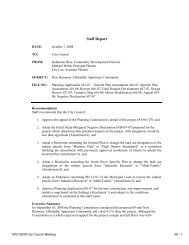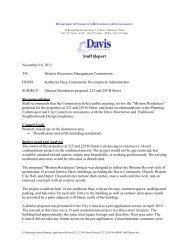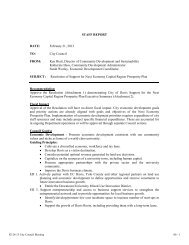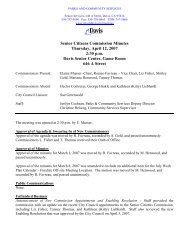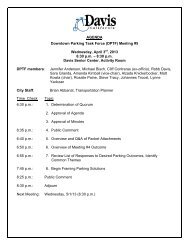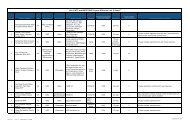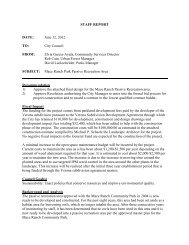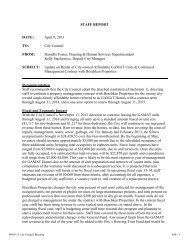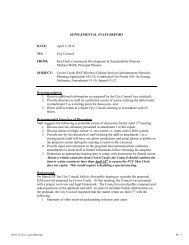10 Draft Integrated Waste Management Plan - City Council - City of ...
10 Draft Integrated Waste Management Plan - City Council - City of ...
10 Draft Integrated Waste Management Plan - City Council - City of ...
Create successful ePaper yourself
Turn your PDF publications into a flip-book with our unique Google optimized e-Paper software.
2012 Davis <strong>Integrated</strong> <strong>Waste</strong> <strong>Management</strong> <strong>Plan</strong><br />
The problem with this option is that the recycling center at DWR is open 24/7. If e-waste is only accepted<br />
during certain hours, there will undoubtedly be an illegal dumping issue with people dropping <strong>of</strong>f e-waste<br />
during odd hours. There are security cameras installed at the recycling center, but this may not be enough to<br />
deter people from illegal dumping.<br />
Illegal dumping will mean that DWR may have other items, refrigerators for example, and other items that are<br />
not accepted as e-wastes. DWR will have to haul those items to the landfill, increasing their operations cost.<br />
Also, since DWR cannot certify that any CED dropped <strong>of</strong>f came from Davis, they cannot receive payment for<br />
those e-waste items.<br />
<strong>10</strong>.2.3 Expand Pharmaceutical Disposal Options<br />
Pharmaceuticals and personal care products (PPCPs) are a diverse group <strong>of</strong> chemicals including prescription<br />
and over-the-counter drugs, nutritional supplements, fragrances, cosmetics, and sunscreen agents.<br />
PPCPs can be introduced into the environment through many routes:<br />
Treated and untreated sewage<br />
Leaching from landfills<br />
Disposal <strong>of</strong> expired and unused PPCPs in the toilet<br />
Animal manure<br />
Industrial manufacturing waste streams<br />
Steroids, prescription and nonprescription drugs and other PPCPs have been detected in water samples collected<br />
from streams considered susceptible to contamination from various wastewater sources, for instance those<br />
downstream from intense urbanization or livestock. Potential risk to aquatic organisms due to exposure to<br />
PPCPs in the environment has been identified as a primary concern given that aquatic organisms may be<br />
continually exposed to chemicals, including multi-generational exposures. There is also concern for subtle<br />
effects on ecological receptors when exposed to low concentrations. For humans, consumption <strong>of</strong> potable water<br />
which may contain trace concentrations (in the part per trillion to part per billion) <strong>of</strong> various PPCPs has been<br />
identified as one <strong>of</strong> the primary potential routes <strong>of</strong> exposure. To date, much research has focused on the<br />
potential for pathogen resistance to antibiotics and endocrine distribution by natural and synthetic sex<br />
steroids. At this time, many unknowns remain regarding the potential for adverse effects on ecological<br />
receptors and humans from exposure to PPCPs in the environment. As new information becomes available, this<br />
will facilitate more detailed evaluations <strong>of</strong> the potential toxicological significance <strong>of</strong> the detection <strong>of</strong> PPCPs in<br />
the environment.<br />
DRAFT<br />
Most pharmaceuticals are accepted for free at the YCCL during HHW events. Federal law prohibits anyone<br />
except law enforcement from accepting controlled substances, since law enforcement agents are not staffing the<br />
YCCL HHW events, pharmaceuticals that contain morphine, Vicodin, codeine and other controlled substances<br />
are not accepted.<br />
At the YCCL, pharmaceuticals get manifested as toxic/poisonous solids, so there is no data on exactly how<br />
much is collected. In 20<strong>10</strong>, a total <strong>of</strong> 41,333 pounds <strong>of</strong> toxic/poisonous solids were collected from Yolo County<br />
residents during HHW events. It is estimated that less than 0.005% <strong>of</strong> those materials are pharmaceuticals,<br />
which equates 207 pounds collected in 20<strong>10</strong>. As <strong>of</strong> August 2011, the YCCL reported an increase in the amount<br />
collected and estimated that approximately 500-750 pounds will be collected by the year’s end.<br />
Page | <strong>10</strong>-92



